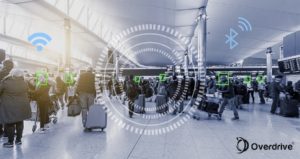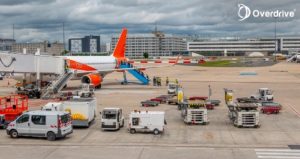Benefits Of An Airport Monitoring Solution

Pre-pandemic, over 4 billion passengers were boarded by the global airline industry yearly. Each day, more than 100,000 commercial flights take off and land. With these numbers set to increase year on year, airports are expected to become even busier places.
To efficiently handle the growth in passenger traffic, the aviation industry is looking to implement airport monitoring solutions which are capable of enhancing and streamlining operations. These solutions utilise Internet of Things (IoT) technologies to obtain real-time data which can then be used to improve safety, reduce downtime, increase passenger satisfaction, and find ways to reduce costs. Here’s a rundown of some of the benefits of implementing an airport monitoring solution.
Learn More: 5 Ways IoT Transforms Businesses For The Better

1. Tracking Airport Vehicle Fleet
Airports aren’t just for your Boeing 747s or your Airbus A380s. There is a bevy of airport vehicles that perform critical functions and are essential to planes landing and taking off on time. Knowing where every single one of these vehicles is parked in real-time, is a big step in increasing the efficiency of airport operations.
To achieve this, fleet management solutions equip airport vehicles with GPS trackers. With such trackers installed, administrators will have full visibility of all airside vehicles. This can help promote a culture of safe driving as driving behaviour can be comprehensively and transparently tracked through both real-time and historical reports. Such oversight can help bring down the number of vehicle-related incidents happening in the airport. This data from airside vehicles will also then be fed to a centralised system that collates this information and displays the overview on dashboards.
Authorised personnel can then access the dashboard to quickly and accurately locate airport vehicles, manage their deployment, and monitor their movement and utilisation. Insights from this process can then be used to reduce wait times for passengers, reduce runway congestion, and make airport operations run more smoothly. A big part of reducing congestion comes from knowing where and when they happen so that airports are able to maximise available gates and spaces to avoid delays, traffic holdups, or unwanted waiting time.
Real-time visibility on roadway conditions through IoT fleet management solutions also allow airports to respond faster and adapt quickly to different scenarios. Once data about roadway conditions is collected and analysed, airports can then also better anticipate changes to better plan airside operations and further reduce delays in the aircraft turnaround process.
Airsides are busy places. Apart from vehicles critical to operations, there are also vehicles such as medical or civil defence vehicles which only occasionally enter the airside. Having a broad overview over all the different vehicles entering and exiting the airside is crucial for both security and day-to-day operations. However, accomplishing this feat is far from straightforward.
With robust IoT solutions in place, the task of tracking the airside is made much easier and simpler. All vehicles which need to enter the airside can be tagged with GPS trackers to ensure that they stick to their role and do not enter unauthorised areas.
2. Monitoring Airport Assets
Many high-value assets such as fuel trucks, baggage carts, and ground support equipment (GSE) are moved around daily in airports. These assets are vulnerable to losses, and in some cases outright theft by employees. In the long term, safeguarding assets can potentially save an airport from losing significant amounts of profit.
IoT-based airport monitoring solutions are able to track the location and movement of these high-value assets for greater accountability and transparency. IoT sensors are also capable of sending out alerts when assets are moved out of authorised zones via virtual geo-fences. Even lower value physical assets such as equipment, baggage carts, wheelchairs, and other non-powered assets can also be tracked easily through IoT solutions.
Airport personnel are crucial to operations and can be considered important assets as well. For flights to land and take off on time, managers need to make sure that their staff are in the right place and ready to handle time-critical situations as required. Tracking airport personnel as part of an overall airport monitoring solution can go a long way in reducing delays, and contribute to smoother operations.

3. Baggage Tracking
Mishandled baggage remains a key issue in the aviation industry, and many airports are investing heavily in solutions that can reduce the cases of misplaced luggage each year to meet performance standards.
IoT based systems can potentially provide cost-effective, end-to-end tracking of luggage via reusable tags and proximity sensors installed across the airport. In tandem, these technologies allow for easy monitoring of luggage and rapid identification and retrieval of misplaced luggage.
Better baggage tracking solutions means lower lost luggage rates and reducing the time needed to reunite passengers with their bags, increasing overall customer satisfaction.
An additional benefit of real-time location tracking for airport baggage, is the prospect of shoring up airport safety and security. With IoT integrations, baggage handlers are able to ensure that only authorised bags are loaded into planes. Any luggage suspected of containing dangerous or illegal materials can also be quickly found and isolated.
In hectic environments like airports, the benefits of IoT monitoring solutions are clear. Operationally they improve productivity, reduce reliance on manual effort, increase accuracy of data, and boost efficiency. In an industry where profit margins have historically been razor-thin, IoT based solutions can provide a crucial edge against the competition and will likely play increasingly important roles in airport operations.
With a suite of holistic IoT solutions for a wide range of industries, Overdrive is a leading real-time asset monitoring company in Asia. Currently deploying for one of the best airports in the world, we are well on our way to rolling out our systems to other airports as well. Contact us today to find out more!



